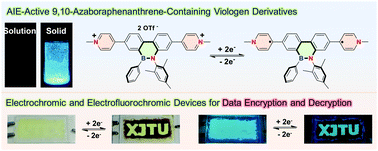AIE-active 9,10-azaboraphenanthrene-containing viologens for reversible electrochromic and electrofluorochromic applications†
Abstract
A series of viologen derivatives containing aggregation-induced emission (AIE)-active 9,10-azaboraphenanthrene (BNPV2+) is reported. The AIE properties of BNPV2+ were attributed to the strong electron transfer between an electron donating azabora-phenanthrene (BNP) and electron-accepting viologen (MV2+) moieties via a twisted intramolecular charge transfer (TICT) mechanism in the aggregated and solid states. BNPV2+ with good redox and AIE properties exhibited electro-chromic (EC) behavior in solution, and simultaneous EC and electrofluorochromic (EFC) behaviors in the aggregated and film states, where the AIE phenomenon can be turned “on/off” by redox processes. The formation of three redox states (dication, radical cation and diradical) was rationalized and supported by the experimental data and DFT calculations. More importantly, the EC and EFC properties of BNPV2+ were successfully used to realize a reversible data encryption system, contributing towards the continuous efforts in the development of new information security technologies.

- This article is part of the themed collections: FOCUS: Recent progress on aggregation-induced emission and Materials Chemistry in Xi’an Jiaotong University


 Please wait while we load your content...
Please wait while we load your content...